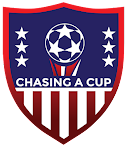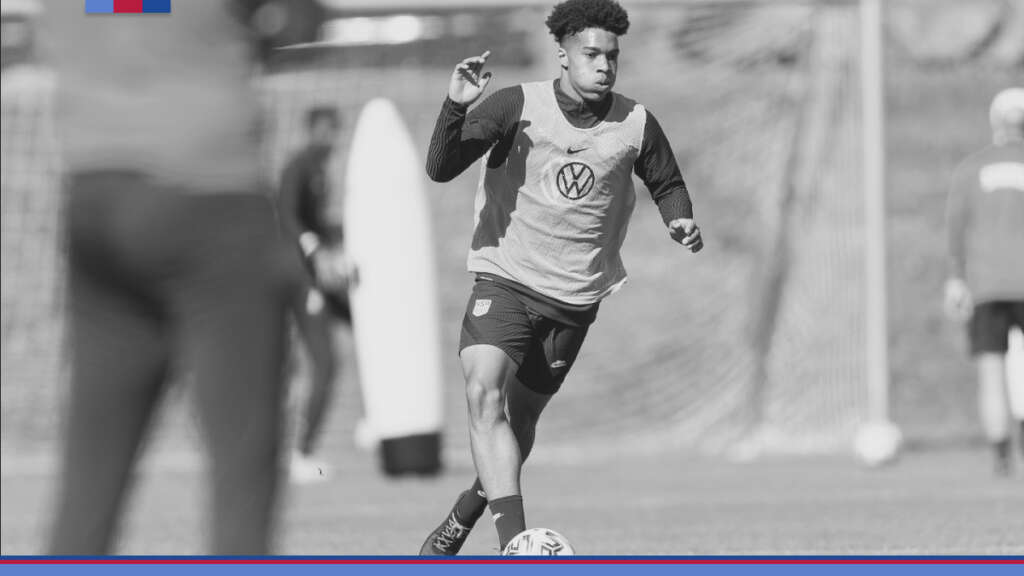

USMNT
USYNT U20 Report – MARCH 2022
Published
2 years agoon
Overview
The U-20 USYNT are preparing for a massive summer where they will play in a Concacaf competition to qualify for the 2023 U20 World Cup and the 2024 Olympics which will take place from June 18 – July 3, 2022, in San Pedro Sula and Tegucigalpa, Honduras. Per Concacaf:
The competition will kick off the third week of June with a Group Stage between the top ranked 16 teams (according to the Concacaf Men’s U-20 Ranking). After Group Stage play (June 18-23) the top three teams in each of the groups will advance to the Round of 16, joining the four CMU20C Qualifiers winners (qualifiers between the lowest ranked nations took place in November 2021, results are available here).
The 16 team Knockout Stage will begin with the Round of 16 (June 25-26), followed by the Quarterfinals (June 29), Semifinals (July 1), and Final (July 3). Further details on the scheduling will be announced after the draw.
All Knockout Stage matches will be played in a single match elimination format, with the semifinalist (four teams) qualifying to the FIFA Men’s U-20 World Cup Indonesia 2023 and the finalists (two teams) to the 2024 Paris Summer Olympic Games.
The draw for the Group Stage of the 2022 CMU20C will take place March 3 (11:00 am ET), at the Concacaf headquarters in Miami, FL. Fans will be able to follow the event via the Confederation’s Official App, Website, Facebook page, and YouTube channel.
For the draw, the top four ranked teams, USA, Mexico, Panama, and Honduras have been seeded into Groups E, F, G, and H respectively. The remaining 12 nations will be split into 3 pots according to their ranking as follows (listed in ranking order per pot and the highest ranked teams in Pot 1):
Pot 1: Costa Rica, El Salvador, Cuba, and Haiti
Pot 2: Canada, Trinidad & Tobago, Guatemala, and Jamaica
Pot 3: Antigua & Barbuda, Suriname, Saint Kitts and Nevis, and Aruba
Teams will be drawn and placed into Groups E, F, G, and H in sequential order, with no more than one team of each Pot per group.
Group E: United States, E2, E3, and E4
Group F: Mexico, F2, F3, and F4
Group G: Panama, G2, G3, and G4
Group H: Honduras, H2, H3, and H4
This team is and will be made up of players born in the year 2003 or later. What is slightly confusing about this dual qualification, is that the 2024 Olympic team will ultimately be open to players born in 2001 or later, yet it’s the 2003s that are qualifying for it.
The team will be led by Mikey Varas who was appointed on November 5th, 2021 right before the Revelations Cup, a set of three matches against Brazil, Mexico and Colombia. Mikey was most recently an assistant at FC Dallas under now USMNT assistant Luchi Gonzalez. FC Dallas is one of the most prolific academies in the US and has been the biggest source of talent for the USMNT and European clubs.
Upcoming Camps
According to USSF, the next camp will be held from March 21 – March 30, during the same International Window that the USMNT will be playing their last WCQ matches. It’s rumored that the U20s will play in a set of friendlies down in Argentina against some very competitive teams.
The USSF has also communicated that there will be a camp from April 22 – May 1, likely the last time this group will get together before the summer. Mikey Varas will have two more camps to bring in different players and settle on a final evaluation ahead of the Honduras tournament.
Player Pool Overview
This team will be predominantly populated by players in the 2003 and 2004 class, though there have been a few 2005s that have participated in recent camps. The 2003 class is widely considered to be one of the strongest that the US has ever produced, with both high end talent and depth. The 2004 group is less acclaimed. They were more heavily impacted by the lack of games during the pandemic and the 2004s have been less prolific in receiving first team deals domestically. There are some very intriguing 2004 prospects that are currently playing within European academies. The challenge with European based players is that youth camps are not camps that clubs are required to release players for, so it can be more difficult to get those players into camps, however the competitive matches this summer are occurring during the European off-season.
Within this article I will detail who has been called into the last two camps, who I think should be in the mix for the summer tournament, and who I would like to see in the March camp, assuming a 26-person squad.
From what we have seen from Mikey Varas, it looks like he will prioritize a similar 4-3-3 formation as the USMNT. Continuity throughout the US system will allow players to integrate and impact more quickly as they move through the ranks. The positions of strength for this age group includes: goalkeepers, left-backs, central-mids (8s) and wingers. The weaknesses of this group include center-backs, defensive-mids (6s) and strikers (9s).
Positional Breakdown
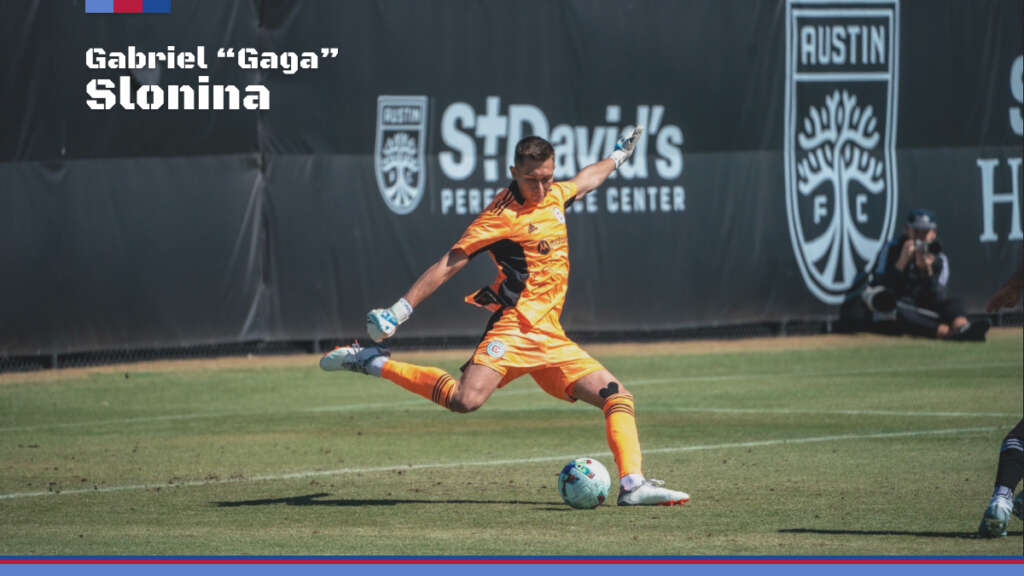
Goalkeepers
This is a really loaded group. The 2004s have the potential to be the greatest class of goalkeepers across the board in US history. There is that much talent. It’s early, so anything can happen. Gaga Slonina is the headliner, but there are many very good analysts that believe Jeff Dewsnup and Chris Brady are just as talented, if not more talented. What a luxury! Unfortunately, only one can play at a time and given Gaga’s recent rise and the fact he’ll be starting week in and week out for Chicago, he’s the likely starter.
The backup spot is completely up for grabs. Neither Dewsnup and Brady have been called into a recent camp, but I think that’s more because of the clubs than US preference. I suspect Dewsnup will be the eventual #2 so that if Gaga has to miss time with Chicago, Brady is there to play in his absence. We shouldn’t count out Alex Borto or Antonio Carrera either. Borto impressed in the November camp and Carrera’s recent camp performance boosted his stock in Feb, with two clean sheets in scrimmages against MLS clubs. Carrera recently signed his homegrown deal with FC Dallas.
Who has been called into last two camps: Gaga Slonina (Nov ‘21), Alex Borto (Nov ‘21), Antonio Carrera (Feb ‘22), KyMani Dada (Feb ‘22), Anthony Ramos (Feb ‘22)
My March call-ups: Jeff Dewsnup, Real Salt Lake City (2004), Chris Brady, Chicago Fire (2004), Antonio Carrera, FC Dallas (2004)
In my pool for the summer tournament: Gaga Slonina, Chicago Fire (2004), Alex Borto, Fulhum U18 (2003), Jeff Dewsnup, Real Salt Lake City (2004), Chris Brady, Chicago Fire (2004), Antonio Carrera, FC Dallas (2004)

Left-Backs
Left-backs are another position of strength, something US soccer fans haven’t heard, maybe ever. For my March call-ups I am assuming that Jonathan Gomez will be able to leave Real Sociedad and he will prioritize the American side over the Mexican side, but there is a high probability that JoGo will stay in Spain for this camp. In a recent interview, it sounded like JoGo was planning to prioritize the American U20 camp over Mexico when the next opportunity arises. If true, he is the overwhelming favorite to start, which will allow Kevin Paredes to play higher up the pitch on the wing.
The backup position is more competitive. My favorite to win the position is Caleb Wiley from Atlanta. He has been in the last two camps and recently signed his homegrown deal with Atlanta where he’ll be the primary backup to Andrew Gutman and the future of that position. Noah Allen has also come on strong for Inter Miami and he is likely pushing Caleb for that spot. I am a fan of both of their games and would like to see them both in camp to continue to compete for the LB2 spot.
Who has been called into last two camps: Caleb Wiley (Nov ‘21, Feb ‘22), Jacob Greene (Nov ‘21), Noah Allen (Feb ‘22)
My March call-ups: Jonathan Gomez, Real Sociedad B (2003), Caleb Wiley, Atlanta United (2004), Noah Allen, Inter Miami II (2004)
In my pool for the summer tournament: Jacob Greene, DC United (2003), Anton Sorenson, Philadelphia Union (2003), Tristan Viviani, San Jose Earthquakes (2004)

Right-Backs
The right-back and center-back depth chart will be impacted by where Mikey Varas wants to play Justin Che. He is probably this group’s best right-back and center-back so it will come down to what role will deliver the most positive impact to the team. I am electing to start him at right-back where is stronger right now and it is also where he is playing for Hoffenheim. Justin gives Mikey flexibility in how he wants to construct the squad and how they can play.
At the moment, my preferred backup is Mauricio Cuevas. He has been this age group’s primary RB for a while, but has been without a club until recently signing with Club Brugge’s reserve team. Still, he is one of the most talented players on this team and was called into the last camp. We’ll see if he gets called back in March. I’d love to see some in-game action and find out how rusty he is.
There are options behind Cuevas if he needs more time to regain form. My sleeper pick here is Alex Freeman, a very toolsy and athletic player that has come on strong over the last year or two. He was recently signed to a homegrown deal and he will likely end up being one of the top 04s.
For March, I want to learn more about the depth of this group, so I’d love to get a first look at Alex Freeman and Devan Tanton to have a full suite of information on this right-back position.
Who has been called into last two camps: Justin Che (Nov ‘21), Kayden Pierre (Nov ‘21), Mauricio Cuevas (Feb ‘22), Michael Halliday (Feb ‘22)
My March call-ups: Alex Freeman, Orlando City (2004), Devan Tanton, Fulham U18 (2004)
In my pool for the summer tournament: Justin Che, Hoffenheim (2003), Mauricio Cuevas, Club NXT (2003), Michael Halliday, Orlando City (2003), Alex Freeman, Orlando City (2004), Devan Tanton, Fulham U18 (2004), Kayden Pierre, Sporting KC (2003)

Center-Backs
This group was one of the glaring weaknesses of that Revelations Cup back in November, granted the team had almost no preparation time beforehand. In February, the group appeared to have improved based on the fact that they had two clean sheets in friendlies against MLS clubs.
The big question here is if Tony Leone is still open to the US project or if he’s fully committed to El Tri. I’ve heard that he is still open, but he’s only joined Mexico camps as of late. This might be the last camp before qualification, so maybe we can convince him to give it a shot? If not, remember that Justin Che can play here and Markus Ferkranus, Thomas Williams and Nigel Prince are also viable options.
Kobi Henry is a big and athletic prospect that seems to be very well thought of within the US ranks and a player who really caught my eye at the Revelations Cup. He was one of the U20s invited to the Senior December camp. He also recently went on a trial in France with Ligue 1 side, Reims, and it’s rumored that he will transfer there once he turns 18 in April.
Jalen Neal is a prospect I am not as high on as some others I respect. I need to see more of him, but it seems like he will be one of the preferred options. The last CB I have in my group is the very skillful Brandan Craig. Brandan is the best passer of this group and has added some much needed strength. We’ll see if he breaks through with the Union this year. He can also play defensive midfield which gives Mikey more flexibility. Brandan might end up being the best defensive midfield option this group has.
Thomas Williams, Marcus Ferkranus and Nigel Prince all fit the mold of big, strong and athletic center-backs that can dominate in the air, but are still developing the more technical sides of their game. They are all high upside players that have shown a lot of growth in the last couple of years.
A few other names to keep an eye on are Alejandro Cano, who was recently called into an El Salvador U20 camp. Hugo is recruiting Salvadoran-Americans hard. Anrie Chase is a really interesting name. He currently plays in Japan but is rumored to be moving to Eintracht Frankfurt when he turns 18. He has only played for Japanese youth teams, but it would be great to get him involved in an upcoming camp. Casey Walls really struggled in the Revelations Cup, but he’s skillful and it’s too early to remove him from the pool completely.
Who has been called into last two camps: Kobi Henry (Nov ‘21, Feb ‘22), Jalen Neal (Nov ‘21), Casey Walls (Nov ‘21), Marcus Ferkranus (Feb ‘22), Thomas Williams (Feb ‘22), Brandan Craig (Feb ‘22)
My March call-ups: Tony Leone, LAFC (2004), Kobi Henry, Orange County (2004), Jalen Neal, LA Galaxy (2003), Nigel Prince, Atlanta United (2004), Alejandro Cano, San Jose Earthquakes (2004)
In my pool for the summer tournament: Marcus Ferkranus, LA Galaxy (2003), Thomas Williams, Orlando City (2004), Nigel Prince, Atlanta United (2004), Anrie Chase, Eintracht Frankfurt in March (2004), Alejandro Cano, San Jose Earthquakes (2004), Casey Walls, San Jose Earthquakes (2003)
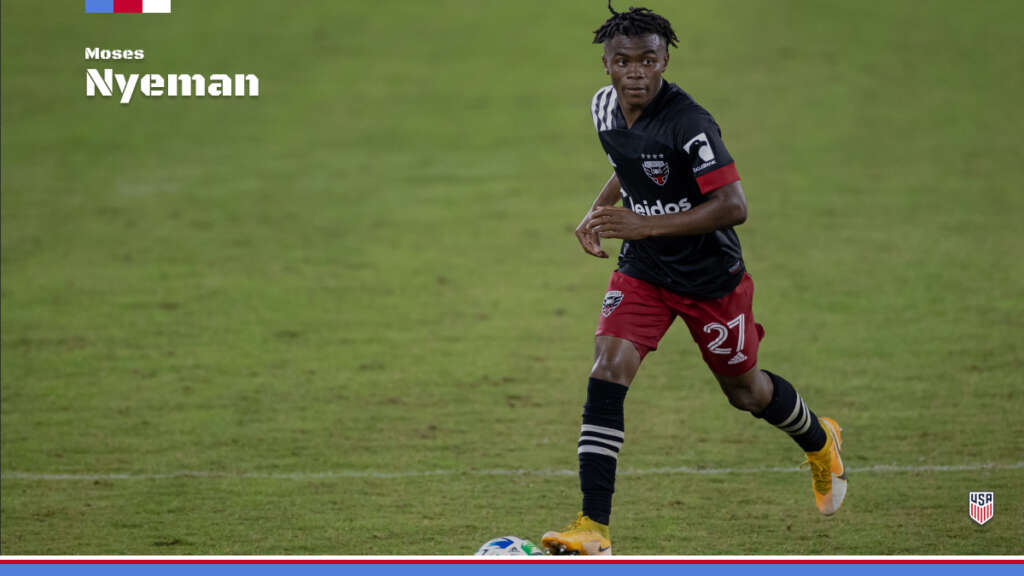
Defensive Midfielders
The defensive midfield position is another where there isn’t a clear starter. There are a few different options that have strengths and glaring weaknesses. From my perspective there are three routes Mikey can go:
Route 1, play the best three midfielders possible, in which case, I would argue that playing Moses Nyeman as a defensive midfielder would be the best option. He’s not a true 6, but he is talented enough to do the job and be more effective than the other true 6 options.
Option 2 is a more technical, ball-controlling 6 like Danny Leyva or Brandan Craig. Danny would improve offensive build-up and switching play, but he’s a big defensive liability.
Option 3 is prioritizing defense and the ability to mitigate danger, in which case Daniel Edelman is the best option. The reality is that all three of these players will likely be on the qualification roster and Mikey will use them all based on the opponent.
For the March camp, I would call in Moses Nyeman who hasn’t yet been in a U20 camp due to injuries and MLS preseason, but he’s sure to be a core member of this team. I would also call back Danny Leyva, if healthy, and I would love to get a look at Atlanta United DM/CB, Efrain Morales, who has a similar skill set as Brandan Craig.
Who has been called into last two camps: Daniel Edelman (Nov ‘21, Feb ‘22), Danny Leyva (Nov ‘21), Jeremy Garay (Nov ‘21), Jayvin Van Deventer, KC Academy (Feb ‘22)
My March call-ups:
Moses Nyeman, DC United (2003), Danny Leyva, Seattle Sounders (2003), Efraín Morales, Atlanta United (2004)
In my pool for the summer tournament: Moses Nyeman, DC United (2003), Daniel Edelman, NYRB (2003), Danny Leyva, Seattle Sounders (2003), Brandan Craig, Philadelphia Union (2004), Efraín Morales, Atlanta United (2004)
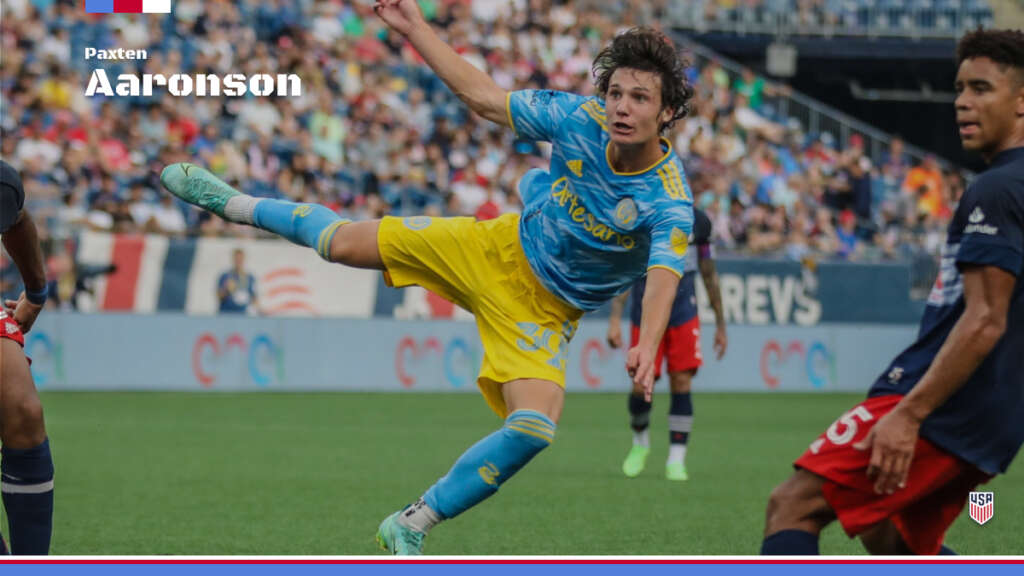
Central Midfielders
As we’ve learned from the USMNT, the dual 8s are a critical component of the US 4-3-3 system. Good news, we have some really strong options within this position group. As mentioned before, Moses Nyeman profiles better here, but I’m sticking him with a weaker 6 group, but he certainly will see time here.
Paxten Aaronson and Quinn Sullivan are locks for this roster. Both are high level prospects who are on the path to having big international futures. Paxten is more of a 10, but I think he can comfortably play here or on the wing depending on what Mikey needs in a given game/situation.
We’ve yet to see Alejandro Alvarado with the U20s and it’s unclear if Mikey rates him or if he hasn’t been available for release from Vizela. Alejandro is a former LA Galaxy academy product who has consistently been selected to the first team matchday squad with Portuguese side Vizela. Alejandro is a Mexican-American dual national who is highly technical and would add a really nice skill set to this midfield.
Another player I would love to see in camp is Kevin Bright who recently transferred from AC Milan’s academy to Cremonese’s academy. He’s a big and athletic midfielder with some very interesting tools. I’d love to see him integrated into the project.
Another player I would call in to camp in March is Zach Booth who recently signed his first professional contract with Leicester City in the Premier League. Zach, little brother of Taylor is just as talented and is playing well in England, recently coming off of a long injury.
Obed Vargas is 2005 and a fast riser. He recently debuted for Seattle in the Concacaf Champions League and was very impressive.
Jack McGlynn is another well known name, another Philadelphia Union player. I don’t love how his skill set fits how the US will want to play and how his skill set fits what we need from the 8s. Jack is a very technical player, but he’s a poor athlete that struggles to press, close down and track back defensively.
Who has been called into last two camps: Paxten Aaronson (Nov ‘21, Feb ‘22), Quinn Sullivan (Nov ‘21, Feb ‘22), Jack McGlynn (Nov ‘21, Feb ‘22), Obed Vargas (Feb ‘22), Rokas Pukstas (Nov ‘21), Javier Casas (Feb ‘22)
My March call-ups: Paxten Aaronson, Philadelphia Union (2003), Quinn Sullivan, Philadelphia Union (2004), Alejandro Alvarado Jr, Vizela (2003), Zach Booth, Leicester City U18 (2004), Kevin Bright, Cremonese U19 (2003)
In my pool for the summer tournament: Paxten Aaronson, Philadelphia Union (2003), Quinn Sullivan, Philadelphia Union (2004), Jack McGlynn, Philadelphia Union (2003), Obed Vargas, Seattle (2005), Alejandro Alvarado Jr, Vizela (2003), Zach Booth, Leicester City U18 (2004), Kevin Bright, Cremonese U19 (2003), Rokas Pukstas, Split U19 (2004), Evan Rotundo, Schalke U19 (2004)

Wingers
The winger group is another position of strength, though the top two players here aren’t necessarily true wingers. Kevin Paredes has played mostly as a wing-back, a position that isn’t used frequently within the US system. He can play as a LB, LW and RW and I project that with JoGo at LB, Mikey will move Kevin up the field to LW. Kevin is among the most talented players in this pool. He has yet to join this group because of injuries and his transfer to Wolfsburg, but I’d expect him there in March if Wolfsburg is cool with it and I definitely expect him with the team this summer.
Caden Clark is another one of the top 5 talents in this group. He is a 10 who can play as an 8 or on the wing and he’ll probably play both of those positions for this team, similarly to Paxten Aaronson. Caden confirmed in an interview with Tactical Manager that he has been playing on the wing for the U20s, so that is why I have him here.
A name that may not be familiar to everyone that I really want to see in the next camp is Luca Koleosho. He plays for Espanyol’s U19 and has spent some time training with their first team. He’s a very athletic and talented winger that is also being pursued by Canada. He was invited to both camps in February and was not able to join the US camp due to club conflicts and was set to join the Canadian camp before it was canceled. It seems that we will have a competition for Luca so we need to get him into camp as soon as we can.
There are two very talented 2005s on my March squad. Bora Aydinlik is a Turkish-American who has yet to play in our setup, but he has been training with the Fenerbahce first team and was on the bench in their last Europa Conference League match. He’s clearly very well thought of and rising quickly. The other is Kristian Fletcher who is fast a rising prospect. He has trialed for Manchester United, Bayern Munich and Borussia Dortmund and is rumored to be heading to BVB, pending passport issues. He’s a very athletic winger who was in the last camp and played as a striker due to the lack of options there.
I didn’t elect to bring Dante Sealy who has been in both camps and will likely make the summer team, but I’d like to use the time in March to experiment with players we haven’t seen yet.
The depth at this position is really strong. Players like Gutierrez, Luna, Oliva and Bajraktarevic are all great options. Perez and Torres are on this list, but they seem committed to Mexico.
Who has been called into last two camps: Caden Clark (Nov ‘21, Feb ‘22), Dante Sealy (Nov ‘21, Feb ‘22), Brian Gutiérrez (Nov ‘21, Feb ‘22), Diego Luna (Nov ‘21, Feb ‘22), Esmir Bajraktarevic (Feb ‘22)
My March call-ups: Kevin Paredes, Wolfsburg (2003), Caden Clark, NYRB (2003), Luca Koleosho, Espanyol U19 (2004), Bora Aydinlik, Fenerbahce U19, Kristian Fletcher, Bethesda SC (2005)
In my pool for the summer tournament: Kevin Paredes, Wolfsburg (2003), Caden Clark, NYRB (2003), Dante Sealy, Jong PSV (2003), Luca Koleosho, Espanyol U19 (2004), Kristian Fletcher, Bethesda SC (2005), Brian Gutiérrez, Chicago Fire (2003), Diego Luna, El Paso Locomotive (2003), Jonathan Perez, LA Galaxy (2003), Yaya Toure, Colorado Rapids (2004), Federico Oliva, Atletico Madrid U18 (2004), Christian Torres, LAFC (2004), Esmir Bajraktarevic, Revolution II (2005)

Strikers
Much like the senior team, the striker position is a bit of a quagmire. Ricardo Pepi would be the obvious choice, but he’ll likely be playing with the senior team. Could he be an option this summer? That would be very intriguing.
For now, I am playing Cade Cowell here. It’s not his best position, but like Nyeman at the 6, he’s a lesser of evils. Cade could be a dynamic front man in the press and lethal as a vertical threat in the counterpress. He also has a nose for goals.
Sanogo has been at the last two camps and he profiles more to how Cowell would play the 9 position. Neither are target strikers, they are both guys who are more effective playing in behind a backline. As mentioned before, Fletcher played there last camp, out of position. Bohui also played there last camp, out of position, he’s more of a winger.
It would be really nice to find a target striker, which is why I would like to give Darren Yapi a try. A big and physical 9 from Colorado.
Who has been called into last two camps: Cade Cowell (Nov ‘21), Malick Sanogo (Nov ‘21, Feb ‘22), Patrick Bohui (Feb ‘22), Kristian Fletcher (Feb ‘22)
My March call-ups: Cade Cowell, San Jose Earthquakes (2003), Darren Yapi, Colorado Rapids (2004)
In my pool for the summer tournament: Ricardo Pepi, Augsburg (2003), Cade Cowell, San Jose Earthquakes (2003), Malick Sanogo, Union Berlin U19 (2004), Kristian Fletcher, Bethesda (2005), Patrick Bohui, Vejle Boldklub U19 (2003), Dzanan Mehicevic, Frankfurt U19 (2003), Tega Ikoba, Portland Timbers (2003), Darren Yapi, Colorado Rapids (2004), Javon Hendricks, Greuther Fürth U19 (2004)
You may like
-
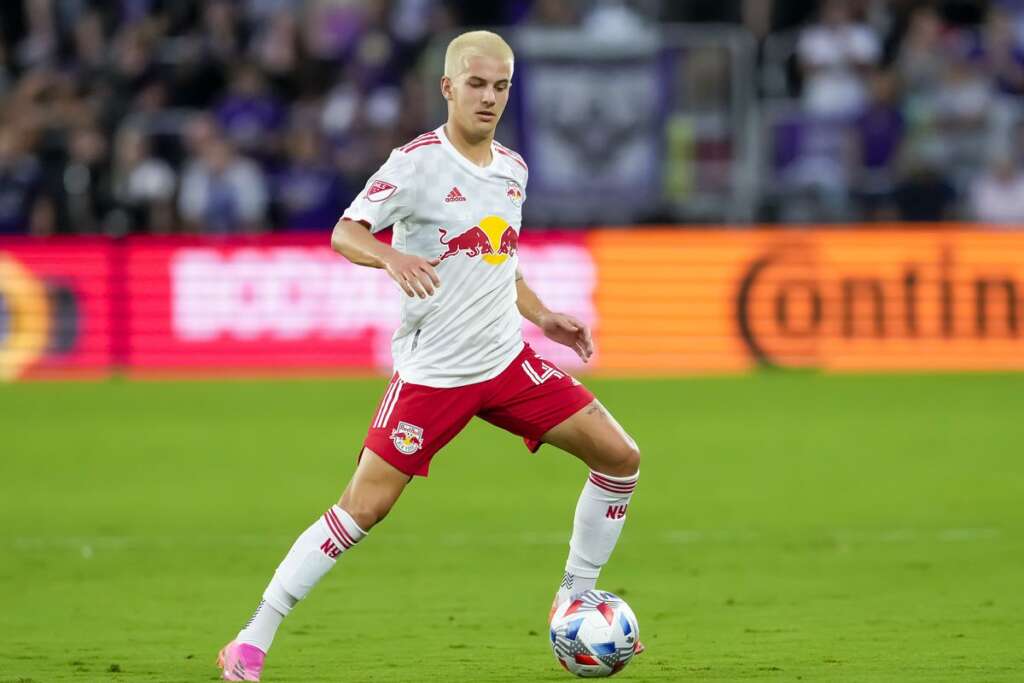

MLS 2022 — American U21 Impact Rankings — Season Wrap Up
-
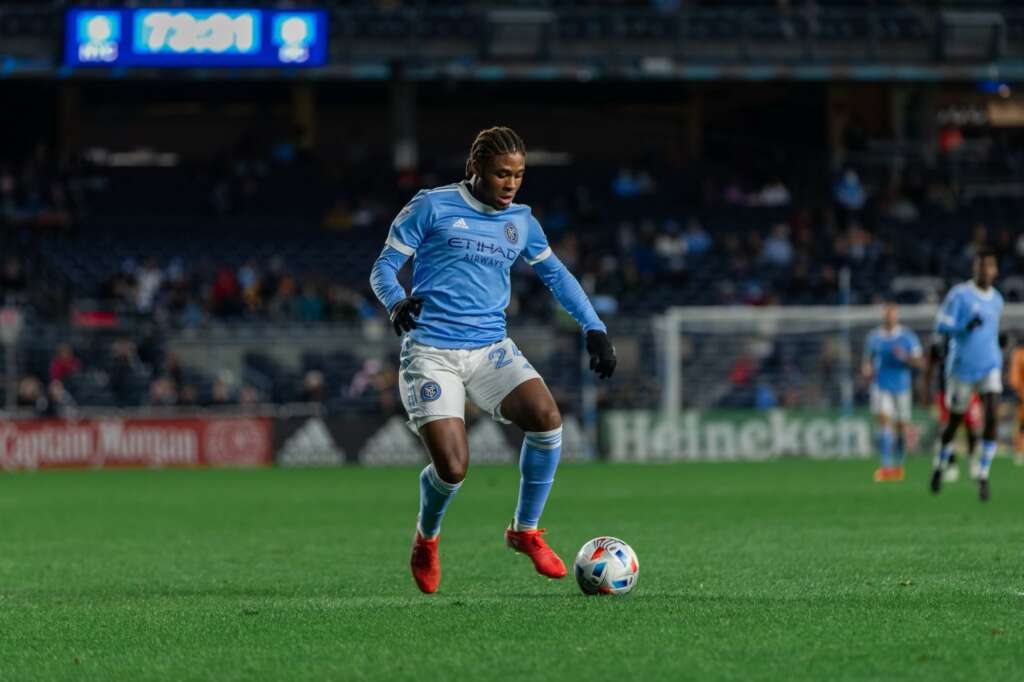

MLS 2022 — American U21 Impact Rankings — Version 15
-


Everything you need to know about the U.S. youth camps this September
-
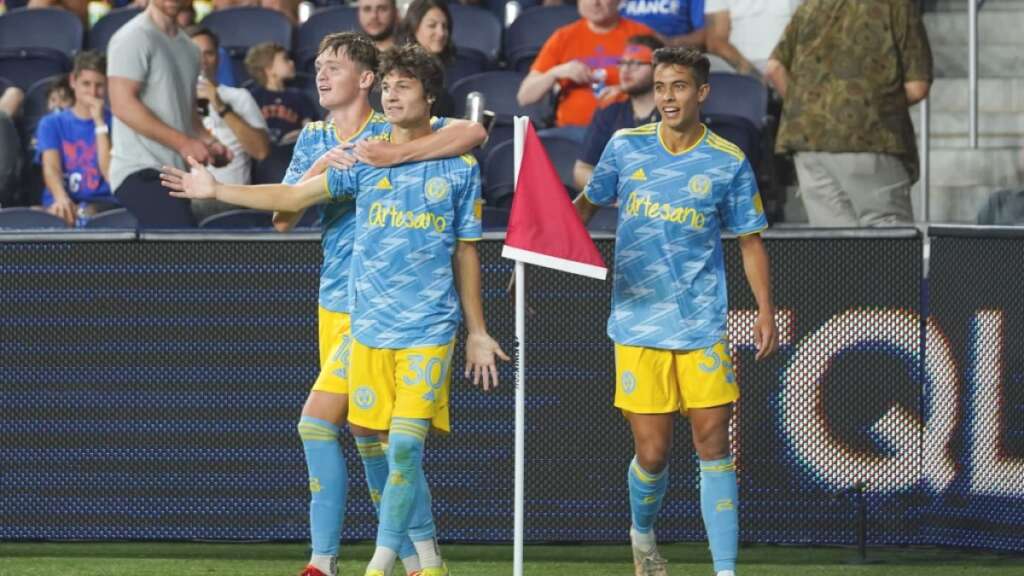

2022 Youth Series: MLS Club Youth Talent Rankings
-
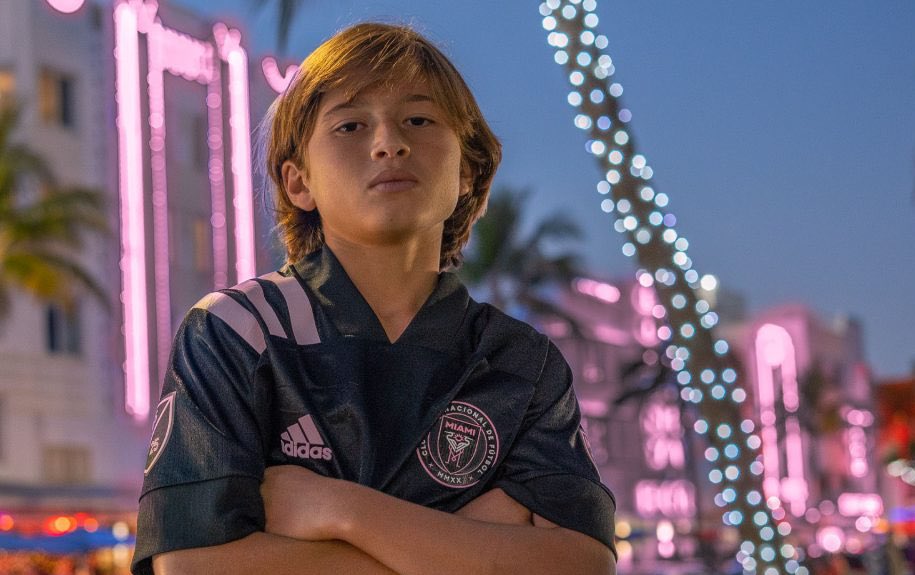

2022 Youth Series: Top 20 Born In 2007
-
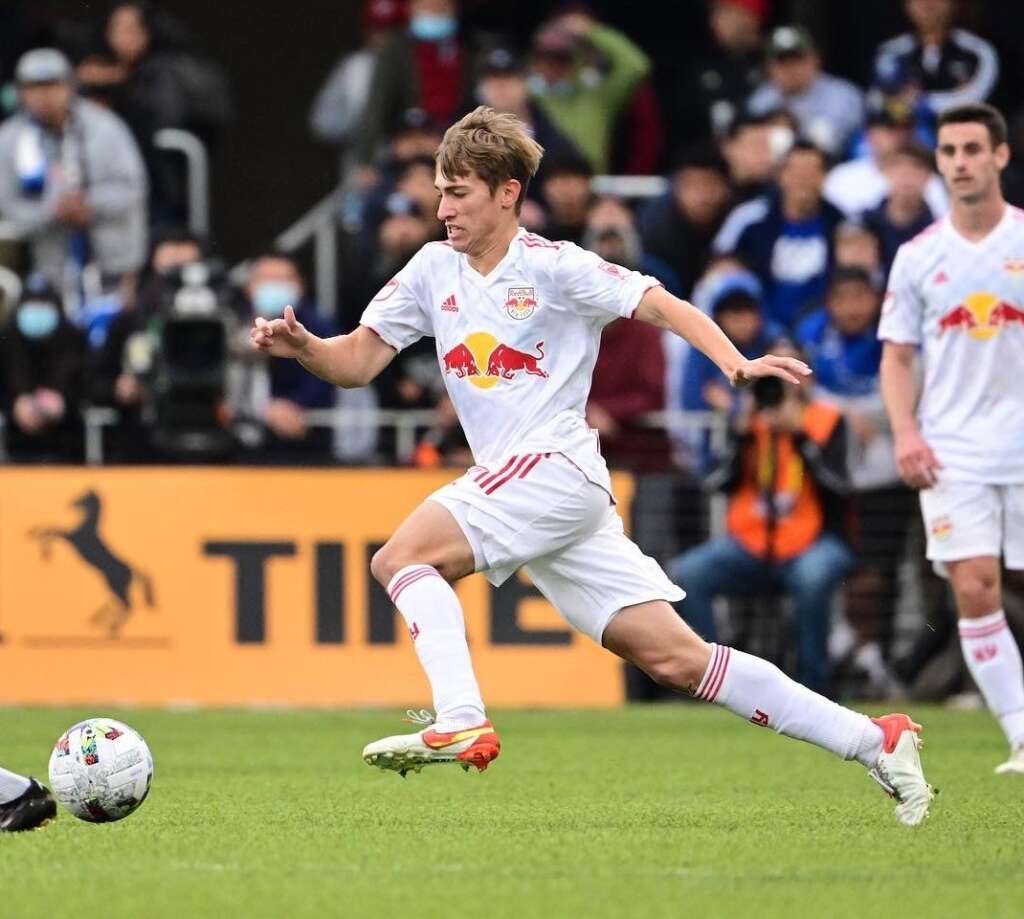

MLS 2022 — American U21 Impact Rankings — Version 14
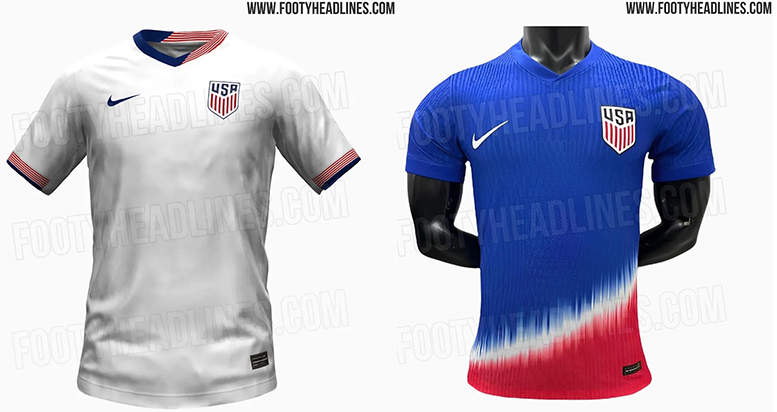
Thomas Deschaine (@uskeeper on X and us_keeper on Instagram)
US Soccer kit releases are something fans get excited about and lately have resulted in disappointment. US Soccer’s recent schedule for kits release during the cycle has seen them releasing another road and or third kits in Gold Cup years and home and away pairs in the even years.
US Soccer is expected to release the 2024 Copa America kits for the USMNT in the coming weeks headed into the Nations League Finals. Last Thursday evening Footy Headlines, who has had a good track record of leaking USMNT kits in the past, provided the below pictures of the home and away USMNT kits. These kits haven’t officially been announced by Nike or US Soccer, but the anticipated announcement is expected in the coming weeks headed into the Nations League Final.

Photo from Footheadlies.com – February 29, 2024
Fake Leaked USMNT Kits
The below USMNT kits were leaked over the last decade, but none of them came to fruition, it’s fun to look at what could have been for the USMNT.
2014 World Cup Kits
These leaked kits headed into the 2014 FIFA World Cup were where loved by many USMNT fans due to the sash and the use of the Centennial Crest, but unfortunately, these kits were fakes and never released.

Photo from SportsLogos.Net – September 13, 2013
2015 Alternative Kit & 2016 Copa America
Generally, US Soccer releases an alternate kit in the years that the Gold Cup is played. This leak kit was reported back in 2015 by NBCSports and then again by MLS Soccer when it was suggested it could be used during the Copa América Centenario.
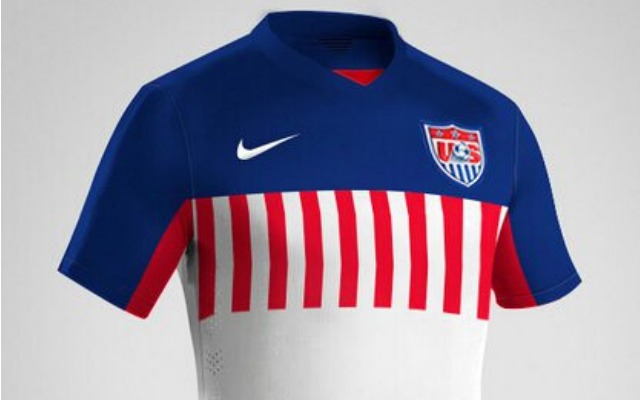
Photo from NBCSports – April 2, 2015
2022 World Cup Kits
I would have much preferred for the USMNT to have worn these kits at the 2022 FIFA World Cup when they ended up, but alas it was another leaked kit that never was.

Photo from proscoccerwire.com – May 6, 2022
2024 Copa America Kit
This rumored kit for the USMNT was based on similar kits worn by the USMNT at the 1924 Olympics and the 1930 World Cup.
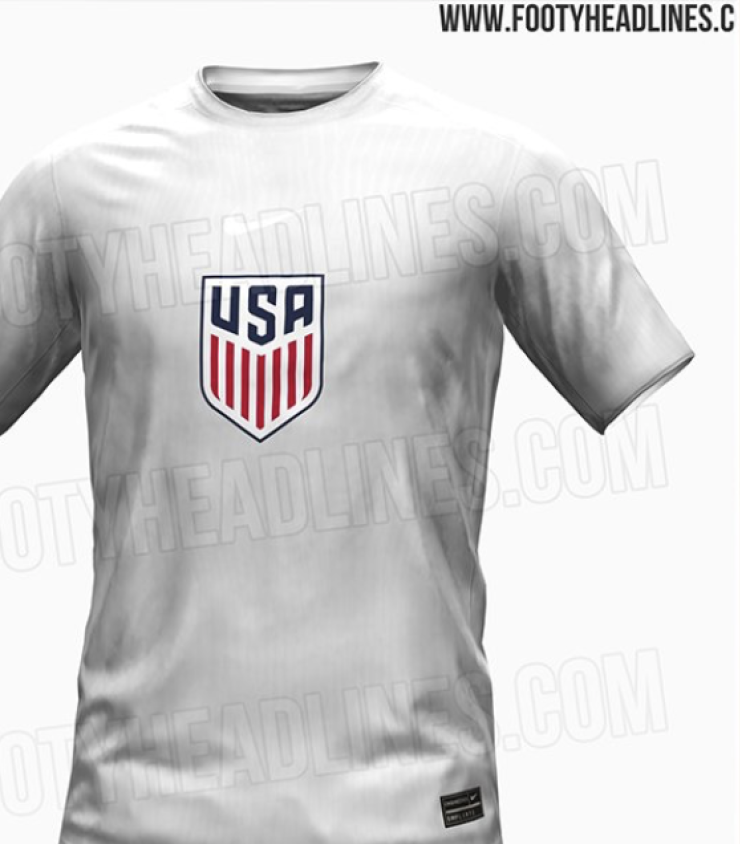
Photo from the18.com via Footieheadlines.com – September 14, 2023
History of US Soccer Crest and USMNT kits
Over ten years ago I began my research of USMNT soccer data in search of a single source site, which I quickly found didn’t exist. Through my research, I started to comply with old USMNT kits and crests from the past. As I acquired more and more kits worn by the USMNT and was able to start to fill in the gaps between them I decided to digitally recreate these kits and share them with the USMNT fans.
Here’s a look at what I was able to find while it seems like a lot I am sure there are many more kits I missed and if so I would love to know which ones so I could create and update what I have already.
History of US Soccer Crests
Here’s the history of the US Soccer crests. I had to recreate several of these crests based on old pictures I found throughout my research since there were no digital images available.
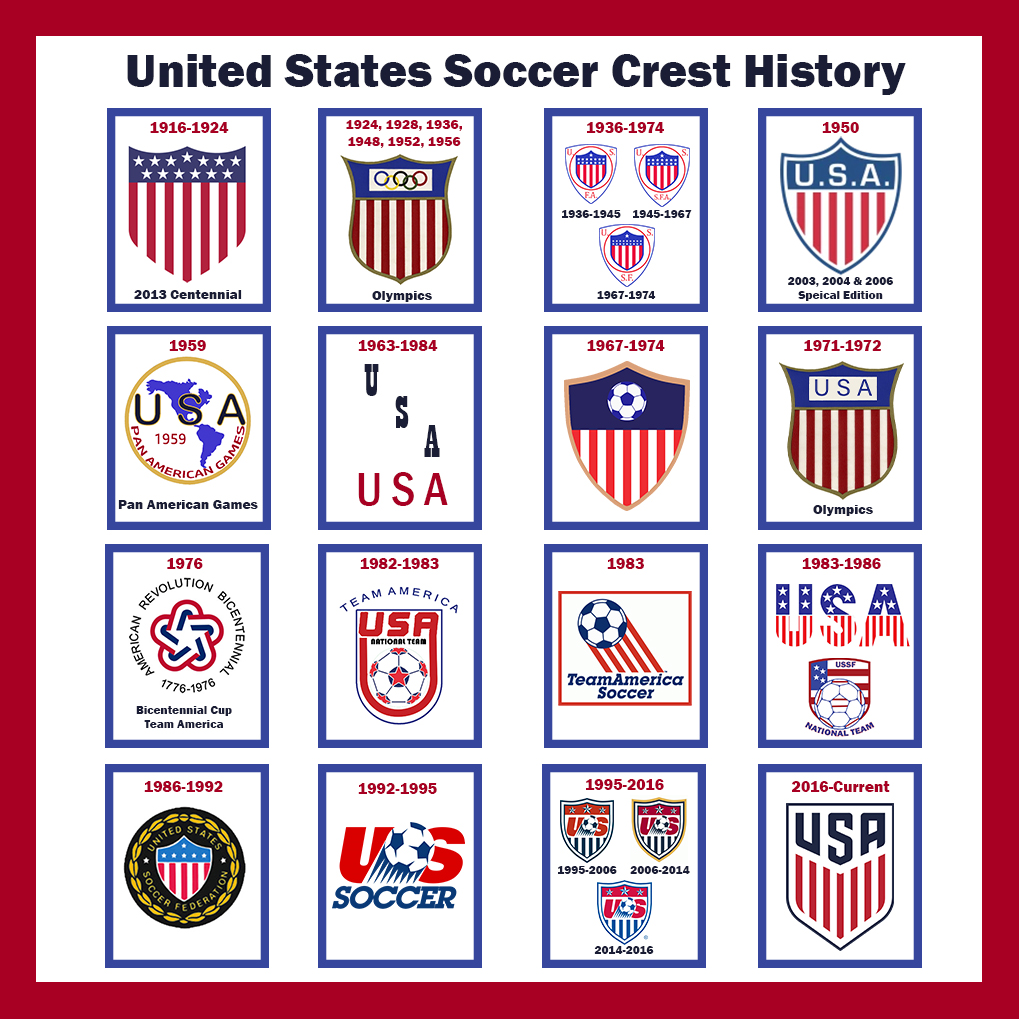
USMNT Kits – 1916-1973
These were the first kits worn by the USMNT which weren’t sponsored. There are variations of these kits worn by the USMNT which comprised of variations of crests and styles, likely due to available funds during this time. My favorite kits in the group are the ones with the sashes from the 1928 and 1936 Olympics and the 1959 Pan American Games.

USMNT Kits – 1974-1983
The group of kits for the USMNT were the first that were sponsored by Adidas. There were a lot of similar styles of kits during this time which really lacked any creativity. My favorite kits in the group are the ones from the middle to late 1970s, there is something about their simplicity and clean look.
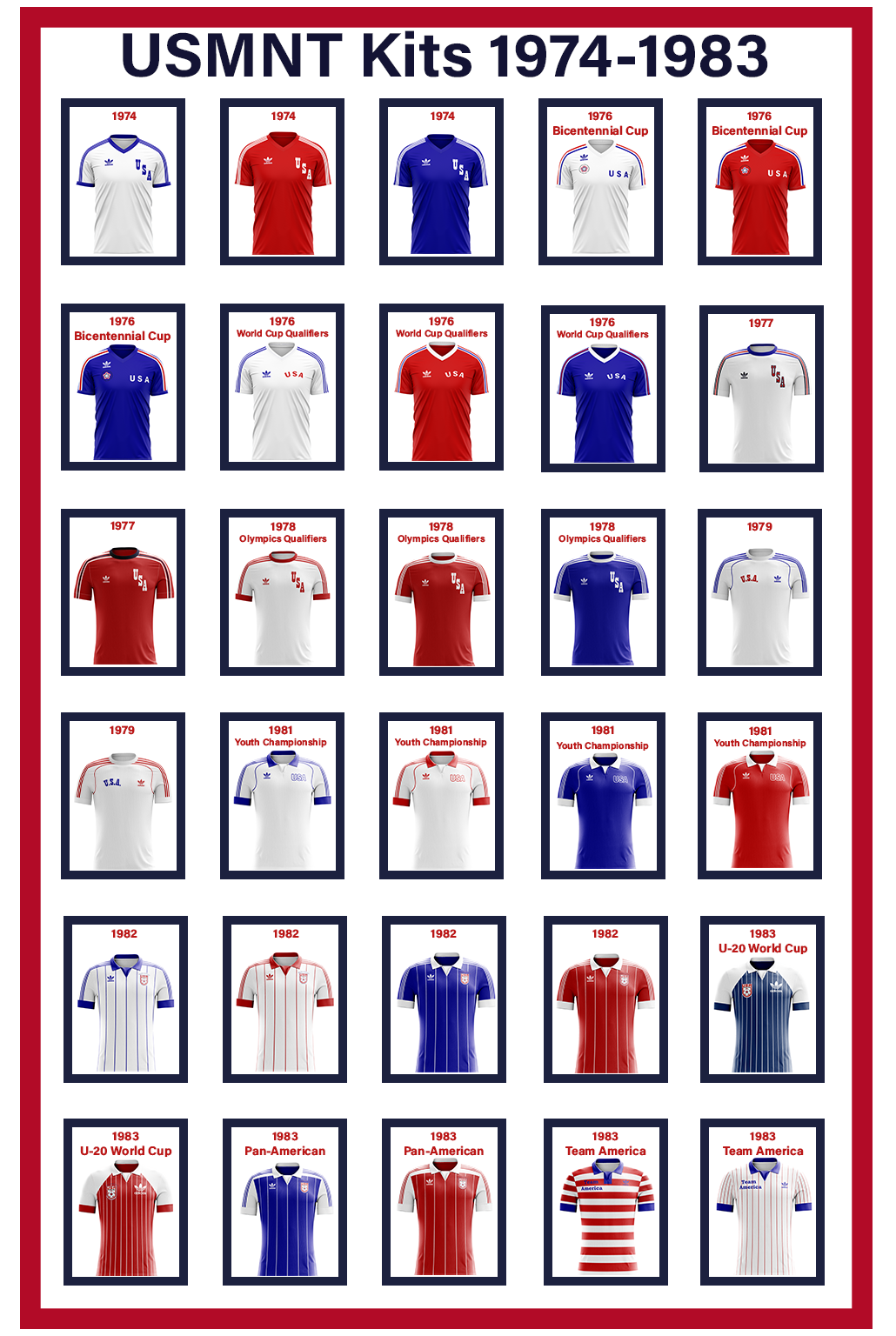
USMNT Kits – 1984-1994
Adidas’s 20-year run of creating kits for US Soccer ended in 1994, with few quality kits made during those couple of decades, which is ironic considering how nice Adidas’s kits are today. My favorite kits in the group are the 1985/1986 blue hoop kit and the 1988 Blue Olympic kit.
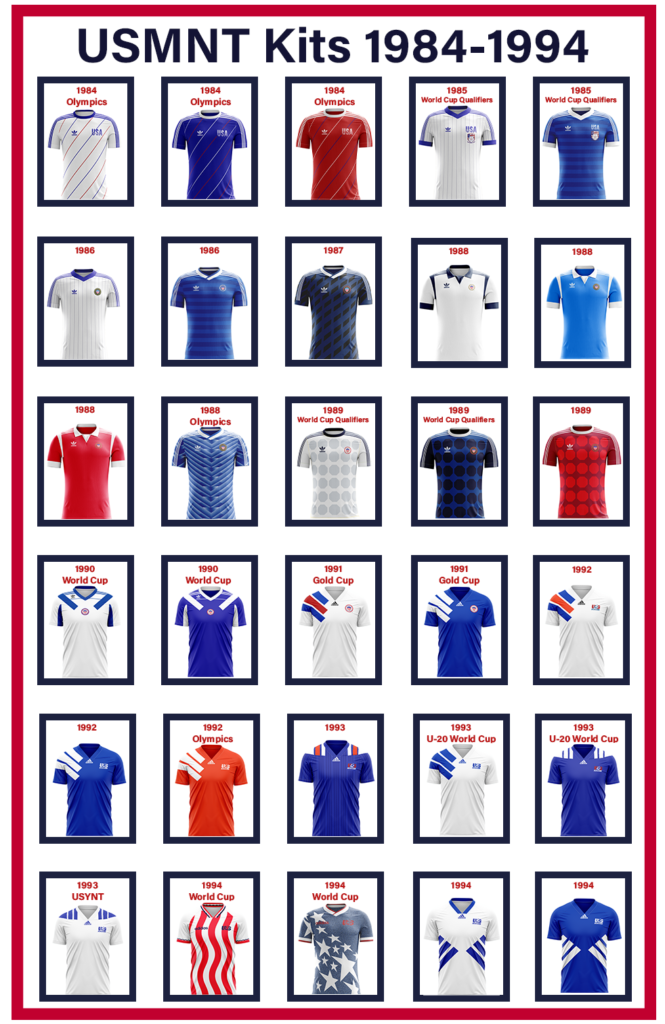
USMNT Kits – 1995-2011
In 1995 Nike took over the creation of the US Soccer kits and started by making three similar kits for the 1995 Copa America and 1996 third kit for the US Cup. Nike did release three Special Edition kits in 2003, 2004, and 2006, which were only worn for one match each. My favorite kits in the group all had a sash on them, which were both the 2010 World Cup kits and the red 2011 Gold Cup kit.

USMNT Kits – 2012-Current
Most USMNT fans would agree that recent kits released by Nike haven’t held the standard seen in the 2010s, where the hoops/stripes that some many fans loved for the 2012 Waldo kits were incorporated. My unsung kits of this group are the 2018 home kit, which would have been worn at the 2018 FIFA World Cup, and the 2017 Gold Cup kit.
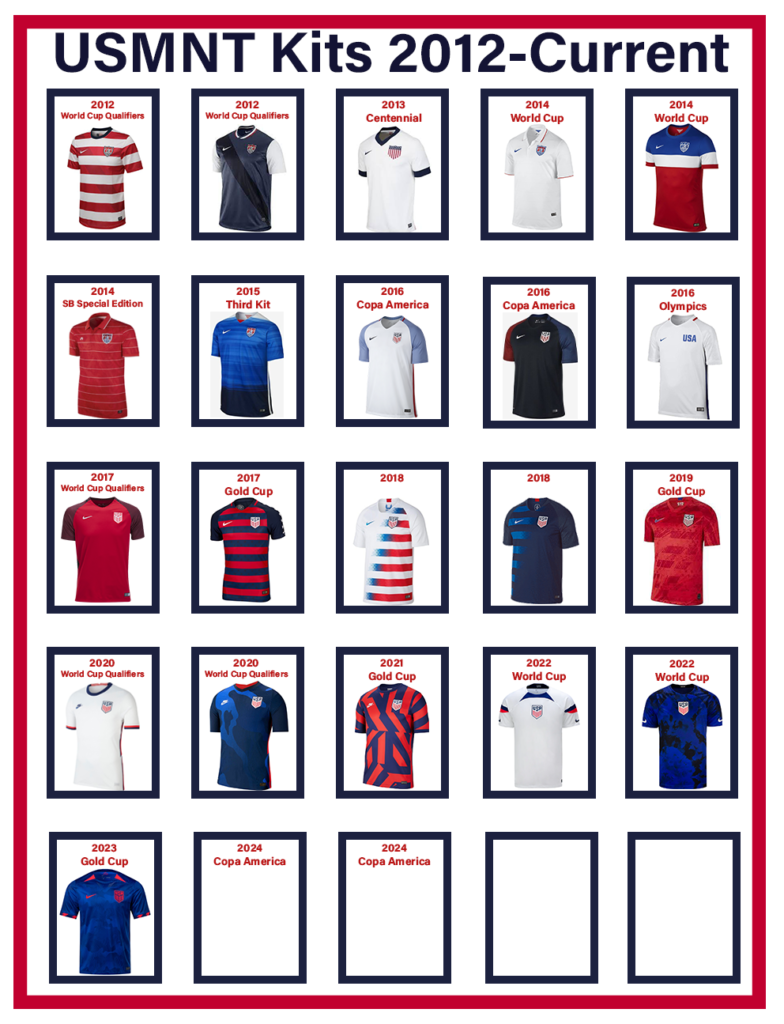
USMNT Kits going forward
Nike and US Soccer signed what was considered a historical long-term sponsor agreement, in November 2021, that went into effect in Janaury 2023 that will run for at least a decade which will cover the 2026 FIFA World Cup and 2028 Summer Olympics and possibly a 2027 or 2031 Women’s World Cup hosted in the United States, so for fans who has hoped for a different kit creator they will have to wait a while.
Once the 2024 Copa America kits are released US Soccer will likely only release one more kit for the 2025 Gold Cup for the USMNT before releasing the 2026 World Cup kits. One idea that I’ve had for a long time was for US Soccer to release Special Edition Kits with styles from the past, with the limited release of those kits, coupled with playing matches in locations and venues throughout the United States to build the fan base and excitement for the 2026 FIFA World Cup.
In conclusion, I am somewhat optimistic that US Soccer and Nike will create some variation of the 2012 Waldo kit & 1994 Stats and Denim kit to be worn as the hosts of the 2026 World Cup.

Thomas Deschaine (@uskeeper on X/Formally Twitter)
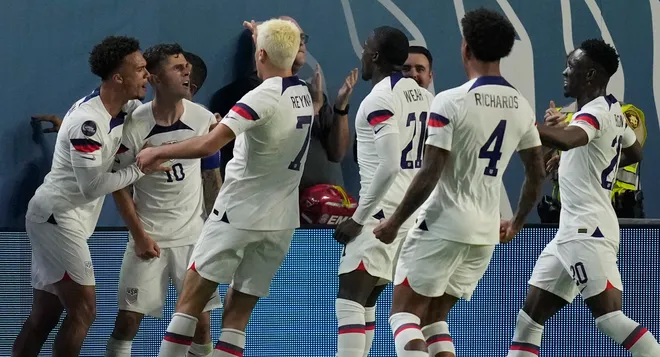
Photo From: USA Today-John Locher, AP – 18, June 2023 – 2023 Concacaf Nations League
As the fog hovered over Estadio Parque Artigas Stadium in Paysandú, Uruguay in the 58th minute Eric Wynalda received the ball on the right wing with Joe-Max Moore making a run forward and in front of Wynalda who delivered a pass to Moore who then went down preventing the ball from being taken away and sending it back to Wynalda who slides forward and scores the third goal of the match and his third goal of the tournament, making it 3-0 USA over tenth-ranked Argentinians and all but sealing the win and the top spot in Group C at the 1995 Copa America. The win for this USMNT consisted of 17 players from the 1994 World Cup team who reached their pinnacle with this group of players finishing fourth at this Copa America.
Over the previous three decades, the USMNT has had some of the biggest wins in the team’s history. During the 1999 Confederations Cup, which was played in Mexico the USMNT played a hard-fought match against the fifth-ranked Germans defeating them 2-0 in the final group stage match and finishing third overall in the tournament. The USMNT would also have an even bigger result against second-ranked Spain in the semi-finals of the 2009 Confederations Cup when they ended Spain’s 35-game unbeaten streak in a 2-0 victory that would send them to the final against Brazil.
2024 is the midway point of the 2026 FIFA World Cup cycle, and the next two windows for the USMNT who as a team and federation need to start ascending to their apex with this group to ensure that they have an amazing performance at the 2026 World Cup.
The USMNT has already played their first match, a 1-0 defeat to Slovenia, but need to quickly focus on the March window 2024 CONCACAF Nations League Finals where they will play Jamaica in the semi-final round and a win would put the USMNT in their third straight Nations League Final where they would have a chance to play either Mexico or Panama and win their third straight Concacaf Nations League trophy.
Some 90 days later the USMNT will be kicking off only their fifth appearance at the Copa America Tournament, with the stakes for this group at an all-time high and where success is demanded from the players, coaches, fans, and the federation. Will this current group of USMNT players and coaches be able to progress to the next level against the elite teams of CONMEBOL? It’s worth noting that the USMNT has finished fourth twice at Copa America in 1995 and 2016, however, the USMNT finished 32nd at the 1998 World Cup and failed to qualify for the 2018 World Cup.
The U-23 USMNT will also be playing the Olympics for the first time since 2008, which provides a great opportunity for those U-23 players to get noticed on a big stage. There are many eligible players who if released by their clubs will have a great opportunity to impress while helping the U-23 USMNT make a deep run at the 2024 Olympics in France.
As it becomes increasingly harder for the USMNT to schedule non-Concacaf opponents the US Soccer Federation will need to get creative in who and where they schedule these Friendly matches. The June window offers up the best opportunities for the USMNT to schedule matches against other CONMEBOL teams, preferably in Groups A and B which feature Argentina, Chile, Ecuador, Peru, and Venezuela.
Edgar Moreno on X, formally Twitter, reported that the USMNT and Colombia have scheduled a Friendly headed into Copa America. It was also reported on Goal.com that Colombia will be scheduling a total of four matches leading into the tournament, two of which will be taking place in Europe. While there are challenges with timing and logistics around scheduling Friendlies with UEFA teams, USSF really needs to do everything possible to secure a similar type of schedule headed into Copa America but, rarely schedules USMNT Friendlies outside of the FIFA International window, which Colombia would need to do to make that schedule work.
It has been recently rumored that the USMNT might close to scheduling a Friendly with Colombia headed into Copa America. The September and October windows have few quality opponents available, at the time of the article it appears that the September window could be an opportunity to play schedule matches with teams from the CAF Confederation, but those matches would likely need to be played at neutral sites in Europe.
2024 USMNT Window
| March | June Window | Copa America | September | October | November |
| CNL Finals March 18-26 | Friendlies June 3-11 | June 20-July 14 | Friendlies Sept. 2-10 | Friendlies Oct. 7-15 | CNL quarterfinals Nov. 11-19 |
Below are eight years since the 1994 cycle that at the time were considered big years for the USMNT as they were playing in FIFA tournaments against teams from other confederations. Below is a look at how they fared.
1992
6 Wins, 4 Draws, 11 Losses, GF-21, GA-27
Third Place at the King Fahd Cup renamed Confederations Cup in 1997 edition.
First at U.S. Cup (Participating teams –Ireland, Italy & Portugal)
Top Goal Scorers
5-Eric Wynalda
3-Hugo Perez
3-Marcelo Balboa
2-Bruce Murray
2-John Harkes
Goalkeeper Stats
5 Wins – Tony Meola
4 Shutouts – Tony Meola
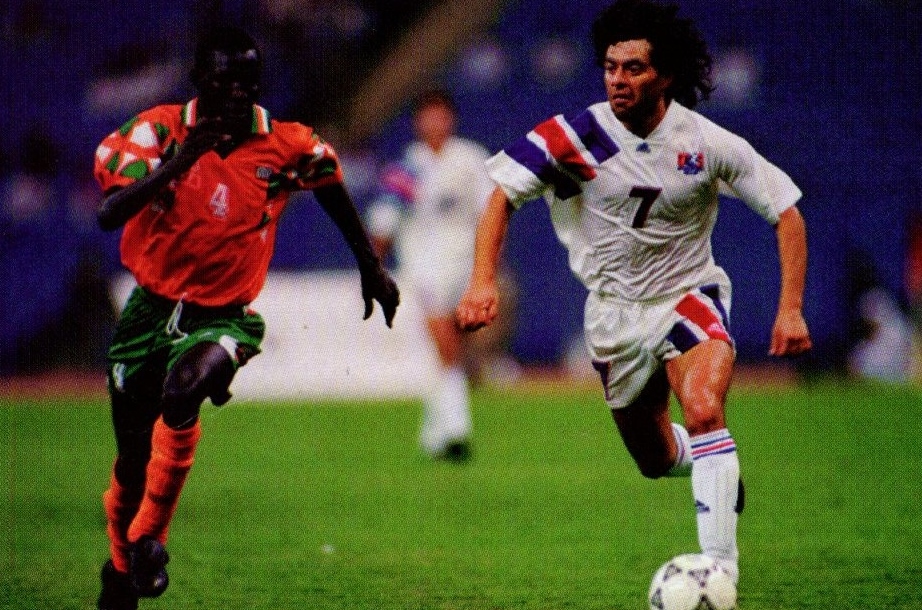
Photo From: Soccer International, Volume 3, Issue 12, December 1992
1993
10 Wins, 11 Draws, 13 Losses, GF-45, GA-44
Twelfth place at Copa America
Second Place at Gold Cup
Third Place at U.S. Cup (Participating teams – Brazil, England & Germany)
34 matches played 1st All-Time
11 Draws tied for 1st All-Time with 1994
13 Loses 1st All-Time
44 Goals Conceded 1st All-Time
Top Goal Scorers
8-Joe-Max Moore
7-Dominic Kinnear
4-Alexi Lalas
4-Thomas Dooley
Goalkeeper Stats

Photo From: El Grafico Number 3847, June 16, 1993
7 Wins – Tony Meola
8 Shutouts – Tony Meola
1995
5 Wins, 3 Draws, 6 Losses, GF-20, GA-18
Fourth Place at Copa America
First at U.S. Cup (Participating teams – Colombia, Mexico & Nigeria)
Top Goal Scorers
3-Eric Wynalda
2-Joe-Max Moore
2-Alexi Lalas
2-John Harkes
Goalkeeper Stats
3 Wins – Kasey Keller
2 Shutouts – Brad Friedel & Kasey Keller

Photo From: DIEGO GIUDICE Associated Press file, July 14, 1995
1999
7 Wins, 2 Draws, 4 Losses, GF-19, GA-11
Third Place at Confederations Cup
Second Place at U.S. Cup (Participating teams – Bolivia, Guatemala & Mexico)
Top Goal Scorers
3-Joe-Max Moore
3-Brian McBride
2-Ben Olsen
2-Jovan Kirovski
2-Frankie Hedjuk
Goalkeeper Stats
2 Wins – Brad Friedel & Kasey Keller
2 Shutouts – Brad Friedel & Tony Meola
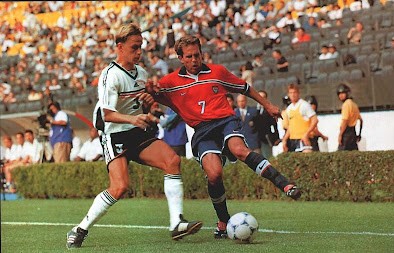
Photo From: FIFA Report- 1999 Mexico, July 30, 1999
2003
10 Wins, 2 Draws, 4 Losses, GF-28, GA-10
Seventh Place at Confederations Cup
Third place at Gold Cup
Top Goal Scorers
7-Landon Donovan
4-Carlos Bocanegra
3-Brian McBride
3-Chris Klein
Goalkeeper Stats
6 Wins – Kasey Keller
5 Shutouts – Kasey Keller
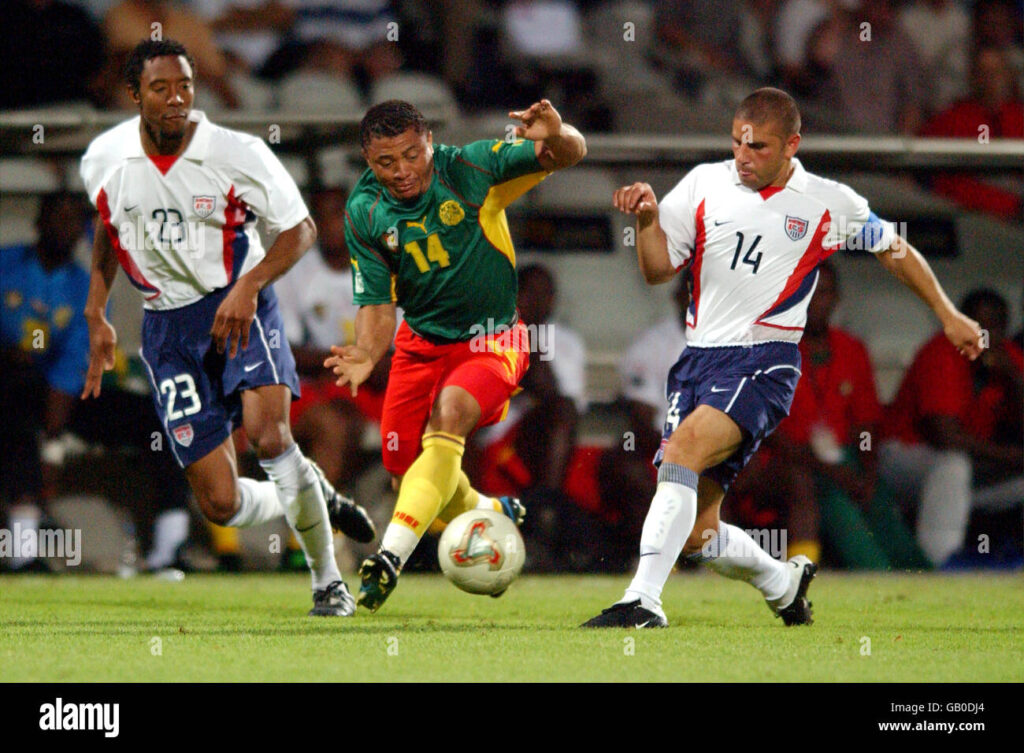
Photo From: FIFA Confederations Cup, June 23, 2003
2007
12 Wins, 1 Draws, 5 Losses, GF-31, GA-19
Twelfth Place at Copa America
First Place at Gold Cup
Top Goal Scorers
9-Landon Donovan
3-Clint Dempsey
3- DaMarcus Beasley
2-Eddie Johnson
2-Benny Feilhaber
2-Carlos Bocanegra
Goalkeeper Stats
8 Wins – Tim Howard
4 Shutouts – Tim Howard
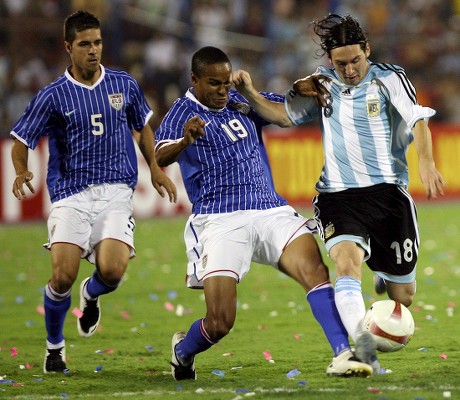
Photo From: Guillermo Legaria – FIFA Copa America, June 28, 2007
2009
13 Wins. 3 Draws, 8 Losses, GF-43, GA-36
Second Place at Confederations Cup
Second Place at Gold Cup
Top Goal Scorers
6-Jozy Altidore
5-Landon Donovan
4-Clint Dempsey
4-Michael Bradley
3- Sacha Kljestan
3- Charlie Davies
Goalkeeper Stats
7 Wins – Tim Howard
4 Shutouts – Tim Howard
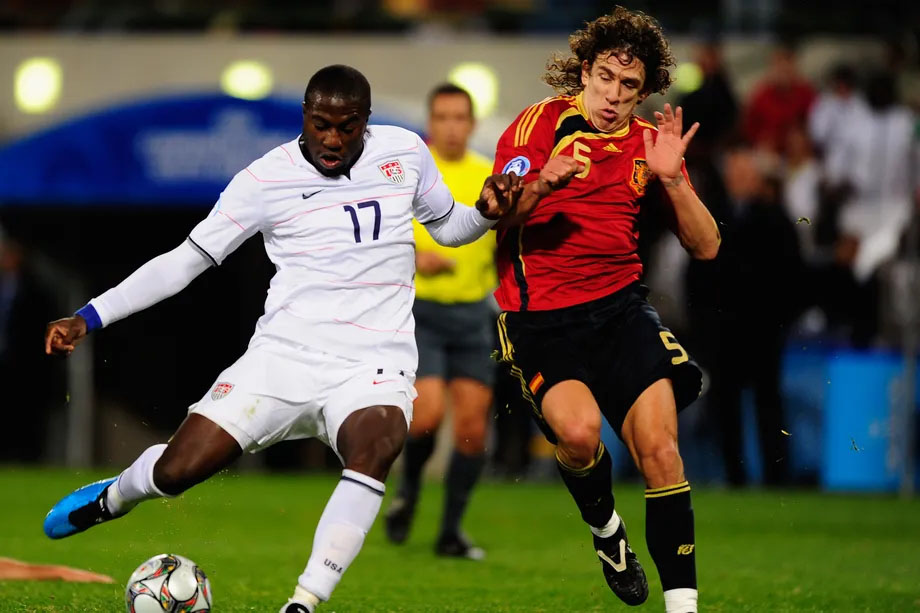
Photo From: Jamie McDonald/Getty Images
2016
12 Wins, 1 Draw, 6 Losses, GF-37, GA-20
Fourth Place at Copa America
Top Goal Scorers
6-Jozy Altidore
4-Bobby Wood
4-Clint Dempsey
3-Christian Pulisic
3-Gyasi Zardes
Goalkeeper Stats
8 Wins – Brad Guzan
6 Shutouts – Brad Guzan

Photo From: Jennifer Buchanan-USA TODAY Sports
Expectations for the in 2024 USMNT
The USMNT is expected to once again advance to the Nations League Final and with their full fit A Squad should be able to bring home their third Nations League trophy, but the 2024 Copa America tournament is very possible the most important non-World Cup the USMNT has even competed it. How success and failure will be determined by the USSF and fans will be interesting to follow. Gregg Berhalter has to prove that he can put together a roster, a formation that allows for simple and effective tactics that will allow the USMNT to not only compete against some top-tier nations but beat them. Success for me isn’t just advancing to the semi-finals of Copa America The USMNT needs to perform at the next level against the top-tier nations, something that I’ve only seen a handful of times in my nearly 35 years as a USMNT fan.
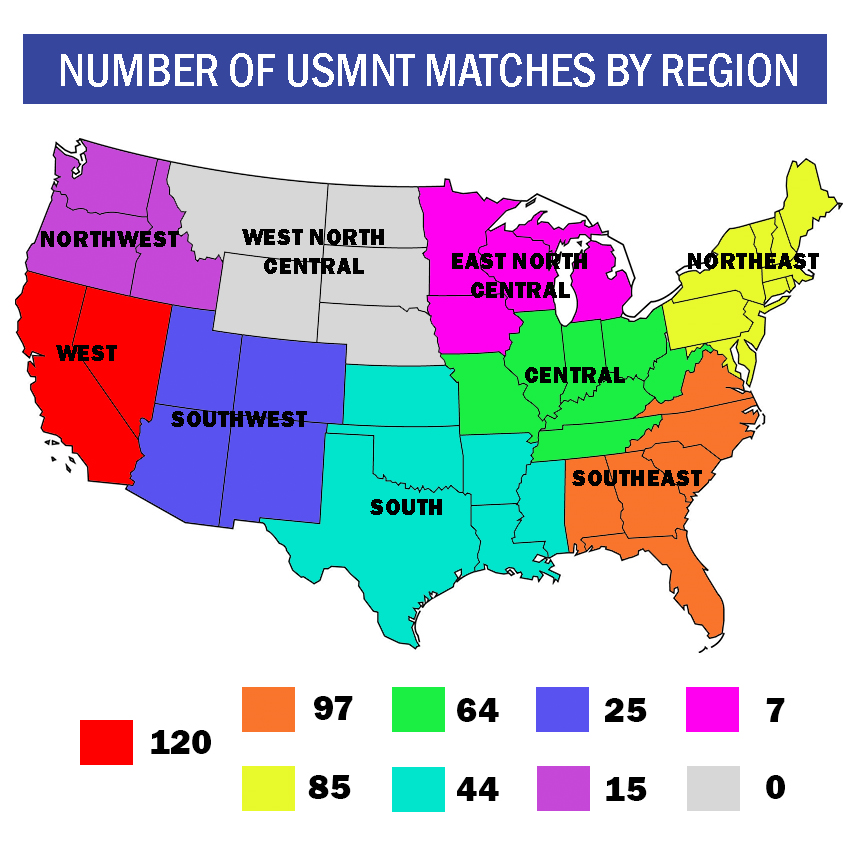
Where the USMNT Should Play Next and Why?
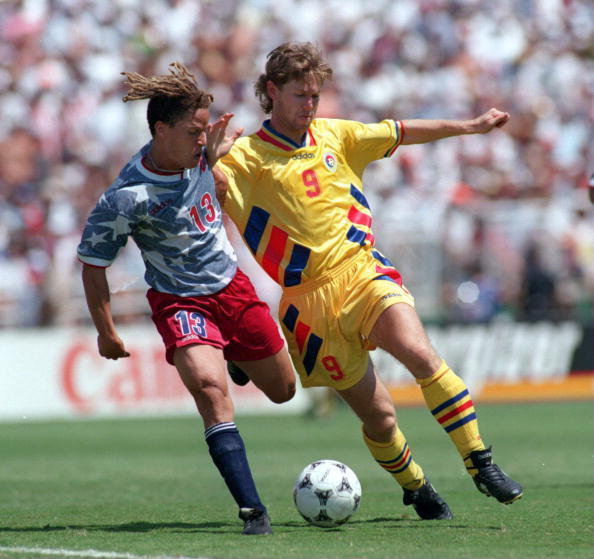
The largest USMNT home attendance of 93,869 took place at the 1994 World Cup in a 1-0 loss to Romania at the Rose Bowl in Pasadena, California.
The U.S. men’s national team announced last month that their only January Camp 2024 Friendly match would be played in the nearly 8,300-seat Toyota Field, home of the USL Championship team San Antonio FC. This marks only the third time USMNT has played a match in a USL venue, the last match was in March 2018, at WakeMed Soccer Park, in Cary, North Carolina. It also marked the 16th time that the USMNT will be playing a match at a venue with a capacity of less than 10,000 (USMNT have played 13 matches at 10,000 seat capacity).
How and where USMNT decides to play matches has recently been scrutinized by fans who live in areas of the United States where matches are rarely — or never — played. Back in March 2023, the USMNT played their final Concacaf Nations League match in Orlando, making its sixth appearance in Orlando since Exploria Stadium opened in 2017. The USMNT has also played seven matches in the state of Ohio since the beginning of the 2018 cycle, four of which have been played in Cincinnati, which is tied for the second most matches played in a city since 2018. USMNT fans nationwide who haven’t been able to attend a local or regional match recently continue to ask why the same handful of venues continue to be selected, even for Friendly matches.
Since the beginning of the 2018 cycle, the USMNT has played 62 home matches at 28 venues, but 10 of those venues have hosted three or more times. The USSF doesn’t have control over which venues the USMNT will play their Gold Cup and Nation League Finals matches, but it does with friendlies, World Cup Qualifiers, and all home Nations League matches.
During the Gregg Berhalter era (yes, I am counting the six-ish months when Anthony Hudson and B.J. Callaghan coached) the USMNT played the second- and third-longest consecutive home match stretches; 15 consecutive home matches in 2019 and 14 consecutive home matches in 2023. Both were years when the Gold Cup was played. The longest stretch was in 1994 when the USMNT hosted the World Cup and played 17 consecutive home matches. As we look forward to 2024 it is possible that the USMNT could reach 16 consecutive home matches played if they can play the maximum amount of Copa America matches and don’t schedule any road or neutral location matches during the September and October windows.
When posting on X (formerly Twitter) about the match at Geodis Park in Nashville, Tennessee, the USMNT account said, “Another stadium to cross off the list,” which appears to be a jab at the USMNT fans about venue selection. The recently scheduled January Camp match scheduled in San Antonio isn’t the first time the USMNT has played in this city. They beat Costa Rica 1-0 in 1988 at Alamo Stadium and in 2015 beat Mexico 2-0 at the Alamodome.

Breaking Down Recent USMNT Home Matches
Below are the US Cities in which the USMNT has played since the beginning of the 2018 cycle up through the group stage matches of Copa America 2024.
| Kansas City, Kansas* | 5 |
| Orlando, Florida | 5 |
| Arlington, Texas | 4 |
| Austin, Texas | 4 |
| Cincinnati, Ohio | 4 |
| Nashville, Tennessee | 4 |
| Carson, California | 3 |
| Paradise, Nevada | 3 |
| St. Louis, Missouri | 3 |
| St. Paul, Minnesota | 3 |
Below are the US States in which the USMNT has played since the beginning of the 2018 cycle through the Copa America 2024 group matches.
| Texas | 10 |
| Florida | 7 |
| Ohio | 7 |
| California | 6 |
| Kansas* | 5 |
| Missouri | 4 |
| Tennessee | 4 |
*All three 2021 Gold Cup Group Stage matches were played at the same location.
In the past, locations and venue selection for World Cup qualifiers haven’t been ideal to ensure a true home-field advantage for the USMNT (see the 2018 World Cup qualifier against Costa Rica played at Red Bull Arena in Harrison, New Jersey). The US Soccer Federation has started to rely on the same 7 or 8 venues for critical matches. But, with the USMNT not needing to qualify for the 2026 FIFA World Cup, USSF has a great opportunity to play in locations they have never played before, or at least in recent memory.
As it currently stands, the USMNT hasn’t played a match in 22 of the 50 states (plus the District of Columbia) and there are seven states in which the USMNT hasn’t played a match in nearly 10 years. Indiana, South Carolina, Louisiana, and Kentucky are the four most populated states to never host a USMNT match, and very much overdue to get matches scheduled at those locations.
One of the seven locations that haven’t seen the USMNT play in over 10 years is Michigan, which has seen two of the largest crowds to watch International Club soccer, the largest attendance of 109,318 in 2014 when Manchester United defeated Real Madrid 3-1 and the 2nd largest attendance of 105,826 in 2016 saw Real Madrid defeat Chelsea 3-2 both were played at the University of Michigan Stadium aka “The Big House”.
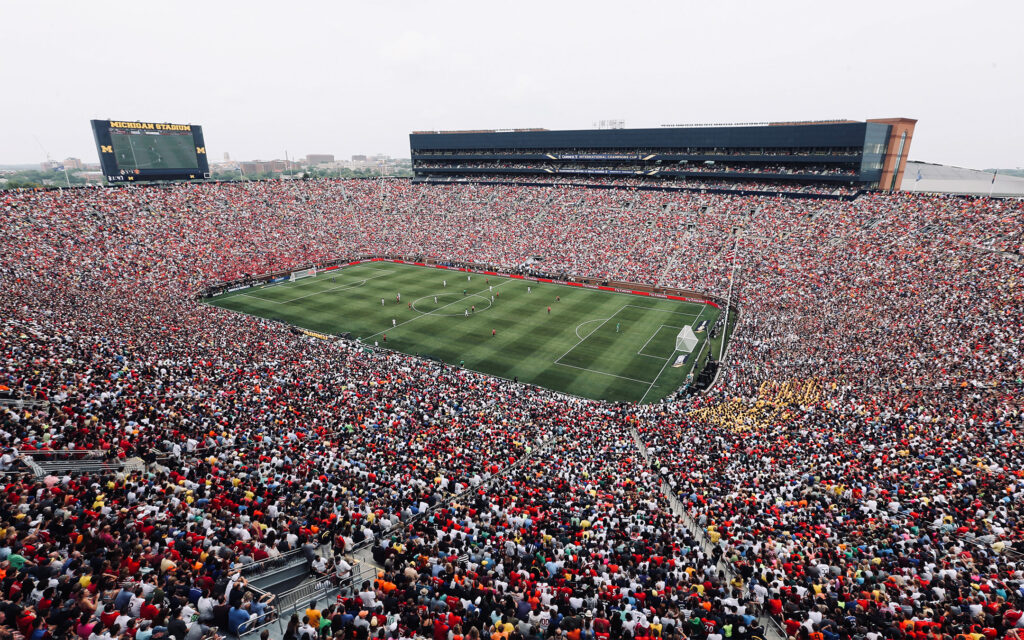
Which State or Venue Should the USMNT Play at Next?
Here’s a look at 10 locations/venues where I would like to see the USMNT play over the next couple of cycles. There are some challenges in getting matches scheduled in certain states and venues due to the playing surface not being grass or the venue not being the required size, which is the case in many of the NCAA football fields.
The below graphic shows the regions where the USMNT has played or already scheduled 457 home matches, up through the Copa America 2024 group stage.

Alabama
Protective Stadium – Birmingham, Alabama
Birmingham Legion FC – USL Championship & UAB Blazers – NCAA Football
Capacity – 47,100
Under the management of Bruce Arena, the USMNT played three matches in Alabama during the 2002 and 2006 cycles, but haven’t returned in almost 18 years.
Last three Matches played in Alabama
March 30, 2005 – 2-0 win vs Guatemala – Birmingham, Alabama – Legion Field – World Cup Qualifier
March 10, 2002 – 1-0 win vs Ecuador – Birmingham, Alabama – Legion Field – Friendly
March 12, 2000 – 1-1 draw vs Tunisia – Birmingham, Alabama – Legion Field – Friendly
Arkansas
War Memorial Stadium – Little Rock, Arkansas
Little Rock Rangers – USL2 & Secondary Home of Arkansas Razorbacks – NCAA Football
Capacity – 54,120
Neither the US Men’s nor Women’s National teams have played a soccer match in the state of Arkansas. Another option could be to play at the recently announced expansion USL Championship team to be located in Northwest Arkansas.
Last three Matches played in Arkansas
No matches played
Hawaii
New Aloha Stadium (2033 – 2038) – Honolulu, Hawaii
University of Hawaii – NCAA Football
Capacity – Expected 25,000 – 30,000
With a new Aloha Stadium expected to be built and hopefully finished in the next 10 years, playing a match in Hawaii seems more likely an option for the USMNT in the future, the perfect opportunity for a January camp location.
Back in 2015, the USWNT had a scheduled victory tour match at the current Aloha Stadium but was canceled on the day of the match because the artificial turf surface at the stadium was deemed unplayable.
Last three Matches played in Hawaii
No matches played
Idaho
Albertsons Stadium – Boise, Idaho
Boise State University – NCAA Football
Capacity – 36,387

Neither the USMNT nor the USWNT has ever played a match in Idaho, or any of the other surrounding states of Montana, North Dakota, and South Dakota. However, in 2015 a friendly match was scheduled at the home of Boise State University at Albertsons Stadium, which is known for its blue surface, aka “Smurf Turf.” The Basque Soccer Friendly featured Athletic Bilbao of La Liga against Club Tijuana of Liga MX in front of a crowd of 21,948 with Athletic Bilbao winning 2–0.
Last three Matches played in Idaho
No matches played
Indiana
Future – Indy Eleven Stadium – Indianapolis, Indiana
Indy Eleven – USL Championship
Capacity – 20,000
The senior USMNT has never played in the state of Indiana. The B Team, however, has played Olympic qualifying matches there for the 1988 and 1992 Olympics, as well as the 1987 Pan American Games, with games not counting as full international caps
Last three Matches played in Indiana
May 10, 1992 – 3-1 win vs Canada – Bloomington, Indiana – Bill Armstrong Stadium – Olympic Qualifying
August 15, 1987 – 0-2 loss vs Argentina – Indianapolis, IN – Kuntz Memorial Soccer Stadium- Pan American Games
May 25, 1987 – 4-1 win vs El Salvador – Indianapolis, IN – Kuntz Memorial Soccer Stadium – Olympic Qualifying
Kentucky
Lynn Family Stadium – Louisville, Kentucky
Louisville City FC – USL Championship
Capacity – 11,700 (Expandable to 15,304)
Louisville City FC has been one of the more successful and popular USL teams in recent seasons and has an amazing fan base. This spurred the building of their soccer stadium in 2018. It is a logical location for a USMNT match.
Last three Matches played in Kentucky
No matches played
New York City
Future – New York City FC – Bronx, New York
New York City FC – MLS Team
Capacity – 25,000
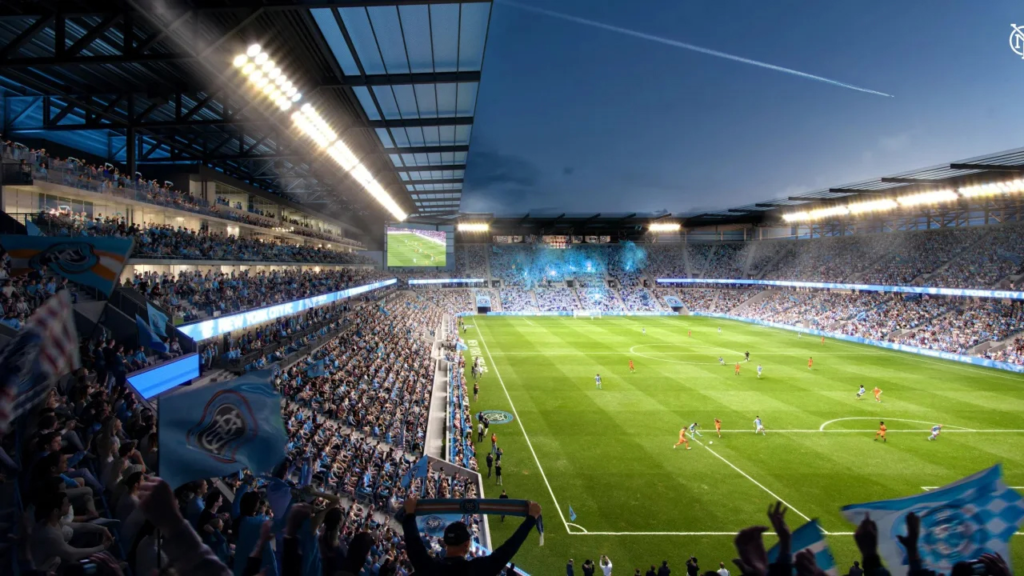
The US Men’s National Team hasn’t played in the New York City area in nearly 40 years, even though they have played matches at the home stadium of the New York Red Bulls which is in New Jersey.
Last three Matches played in New York City Area
November 30, 1984 – 0-0 draw vs Ecuador – Hempstead, New York – Hofstra Stadium– Friendly
September 15, 1968 – 3-3 draw vs Israel – Bronx, New York – Yankee Stadium – Friendly
May 27, 1964 – 0-10 loss vs England – Randall’s Island, New York – Downing Stadium – Friendly
New York (Upstate)
Future – Buffalo Bills stadium (2026) – Orchard Park, New York
Buffalo Bills – NFL Team
Capacity – 62,000
The US Men’s National Team has never played in Upstate New York and with the new stadium being built for the Buffalo Bills — expected to be finished sometime in 2026 — the area would have a good venue for the USMNT to play.
Last three Matches played in Update New York
No matches played
New Mexico
Proposed – New Mexico United Stadium – Albuquerque, New Mexico
New Mexico United – USL Championship
Capacity – 12,000
Another stadium option for the USMNT in New Mexico would be University Stadium also in Albuquerque, which had a seating capacity of over 30,000, however the overall attendance in the only three matches played there wasn’t impressive.
Last three Matches played in New Mexico
March 19, 2005 – 1-0 win vs Honduras – Albuquerque, New Mexico – University Stadium – Friendly
April 30, 1994 – 0-2 loss vs Chile – Albuquerque, New Mexico – University Stadium – Friendly
June 7, 1988 – 0-1 loss vs Ecuador – Albuquerque, New Mexico – University Stadium – Friendly (Clasico International Cup)
Oregon
Providence Park – Portland Oregon
Portland Timbers – MLS
Capacity – 25,218

It’s been 10 years since the USMNT has played in Oregon and with the Pacific Northwest being a soccer-crazed region, is time for the USMNT to return, while the stadium is currently using field turf they would have to make the necessary accommodations to support a grass service.
Last three Matches played in Oregon
July 9, 2013 – 6-1 win vs Belize – Portland, Oregon – Jeld-Wen Field – Gold Cup-Group Stage
May 24, 1998 – 2-0 win vs Kuwait – Portland, Oregon – Civic Stadium – Friendly
September 7, 1997 – 1-0 win vs Costa Rica Portland, Oregon – Civic Stadium – World Cup Qualifier
Other venues and locations considered were Paladin Stadium at Furman University in South Carolina, Memphis 901 FC recently announced a new 10,000-seat stadium to be built in Memphis, Tennessee in the next several years, and Riccardo Silva Stadium home of the USL Championship team Miami FC. Louisiana is another state which has two venues, the Tad Gormley Stadium and the Superdome both of which the US Women’s National Team has played at in the past and could be suitable options for the USMNT in the future.
What are the next and necessary steps for the US Soccer Federation?
With so many high-profile soccer tournaments to be played in the United States over the next six years, this is a great opportunity for the USSF to expand its reach and bring the USMNT to places it’s never been. As it relates to attendance and ticket pricing, the USSF needs to figure out the formula that would allow for maximum capacity at all home matches while allowing for the federation to bring in the necessary revenue desired. Here’s hoping that the United States Soccer Federation sees it the same way and acts accordingly.
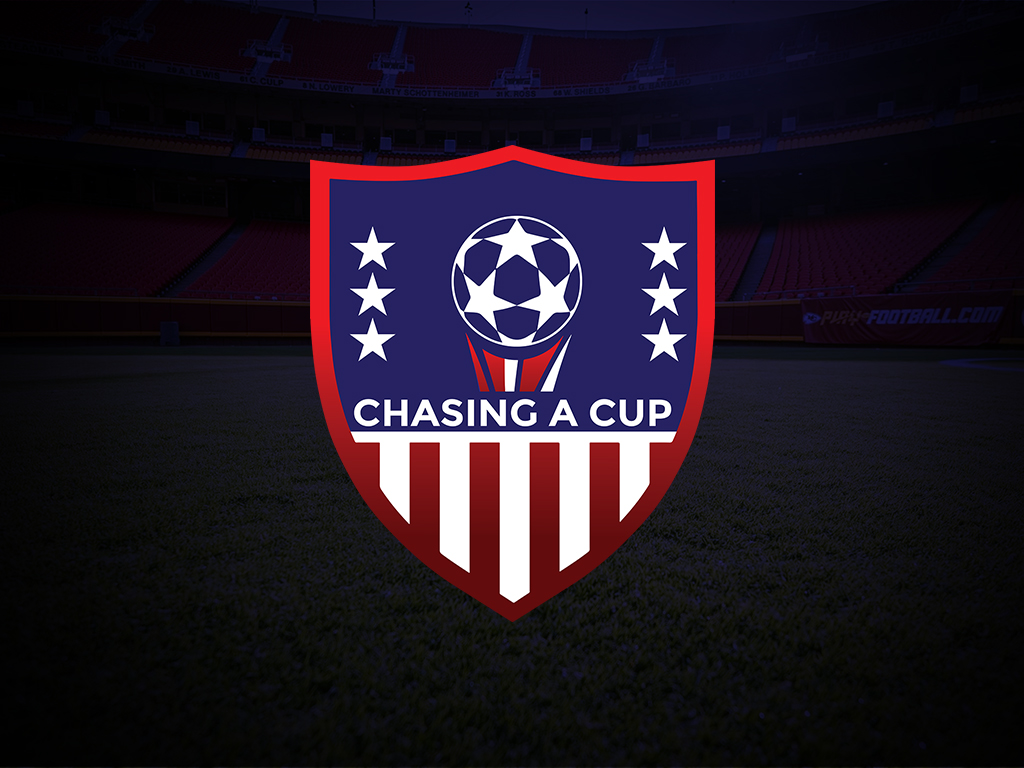

USMNT Kits Come in Different Styles and Colors

2024: A Pivotal Year for the USMNT

USMNT’S Next Great Location

Trending
-

 USMNT2 months ago
USMNT2 months agoUSMNT Kits Come in Different Styles and Colors
-

 USMNT1 year ago
USMNT1 year agoGROUPED OR GLORY: Group A
-

 Club News4 years ago
Club News4 years agoJulian Vincente Araujo
-

 MLS2 years ago
MLS2 years ago2022 Youth Series: MLS Club Youth Talent Rankings
-

 USMNT3 years ago
USMNT3 years agoA Hidden Gem: Barça Residency Academy
-

 Youth2 years ago
Youth2 years ago2022 Youth Series: Top 20 Born In 2007
-

 Club News4 years ago
Club News4 years agoRanking the top 50 American under 20 talents
-
USMNT4 years ago
MLS Quota

